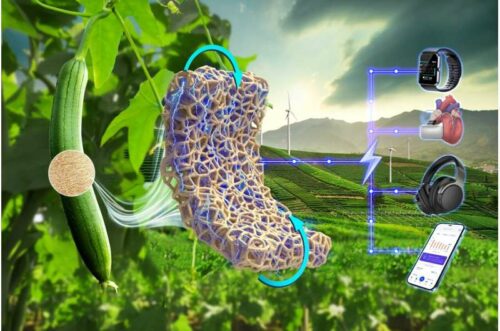- Compressing specially treated luffa sponges has generated small amounts of electricity, opening the door to innovative possibilities.
- While the current output may be modest, the prospect of engineered luffa sponges and scaled-up versions holds promise for a future where these natural materials power devices.

In recent years, engineers have been exploring the potential to generate amounts of piezoelectric power from everyday activities, such as walking or clothing, while someone is in motion. This electricity, harvested from such activities, promises to recharge personal devices. In their latest endeavour, the research team delved into utilising a novel material for piezoelectric generation—luffa sponges.
A collaborative team of mechanical engineers from Beihang University, Peking University, and the University of Houston has recently made a discovery. They have demonstrated the ability to harness small amounts of electricity through the repetitive compression of specially treated luffa sponges. Previous research has elucidated that applying force or stress to specific materials can lead to the accumulation of a piezoelectric charge. Prior studies have established that the cyclic application and release of this force or stress can yield a continuous flow of piezoelectricity.
Luffa sponges are the porous remnants that remain after a luffa plant’s fruit has dried. These sponges have been traditionally processed and marketed as a consumer product, primarily used as an exfoliating tool in the shower for skin exfoliation. However, in their latest undertaking, the researchers explored the potential of luffa to generate limited amounts of electricity. Initially, they subjected the luffa sponges to chemical treatments to eliminate hemicellulose and lignin components, leaving behind a crystalline cellulose shell. Subsequently, they integrated these treated samples into an electrical circuit and commenced a repetitive manual squeezing process. Remarkably, the research team successfully generated a maximum of 8 nanoamps of electricity through this method.
They acknowledge that the electricity generated is currently quite minuscule and may not have practical applications. Nevertheless, they propose the potential development of artificially engineered luffa sponges that could offer greater efficiency in electricity generation. Furthermore, the possibility of scaling up the size of these sponges is also considered, as it could lead to the production of more substantial amounts of usable electricity. Their study, featured in the Proceedings of the National Academy of Sciences, involved the treatment of luffa sponge samples, followed by measuring the electrical charge they generated when subjected to repetitive squeezing.







